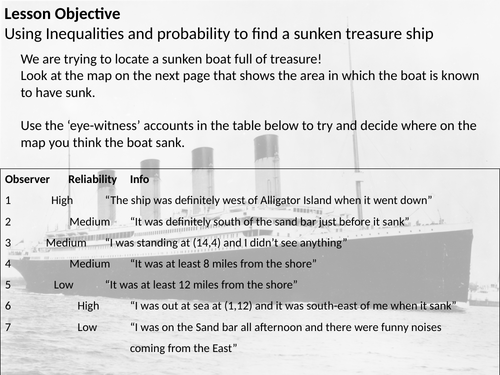








Students often wonder what the practical use of mathematics might be in the real world, beyond basic arithmetic.
This lesson shows and models how historians use coordinates, inequalities and probability to search for sunken ships or lost treasures.
The basic premise is that the search field is divided into a coordinate grid. Eye witness statements/evidence indicating the whereabouts of the lost artifact are turned into inequalities and used to score different coordinate squares in the search field. A higher score is given to evidence from a more reliable source. When all the inequalities have been plotted, and each square scored then the squares with the highest score in the search field are those with the highest probability of finding the treasure. When searching for treasure, especially at sea, resources and time are limited so this technqiue is used to optimise search time.
This lesson was inspired by a video I saw on the The Future’s Channel - which is subscription only: Web address http://thefutureschannel.com/#loaded and to which I have no affiliation, entitled ‘Undersea Treasure’.
The lesson includes:
Easy Treasure hunt map power point - this is a bonus fun coordinates activity that could be used as a starter and is suitable for KS2, KS3 and KS4
Power Point: Lesson On Sunken Treasures - Activities and everything you need to teach the lesson
Lesson On Sunken Treasures - Notes - Notes on how to teach use the Power Point above
Treasures Maps - Intermediate
Worksheet to practise the technique - suitable for KS3 and KS4 with answers
Treasure Maps - Hard
Worksheet to practise the technique - suitable for KS3 and KS4 with answers which is harder difficulty
Give Clues for Treasure 1 and 2
Again differentiated worksheet where students have to describe the optimum search field using inequalities (reverse process). With answers.
Something went wrong, please try again later.
This resource hasn't been reviewed yet
To ensure quality for our reviews, only customers who have purchased this resource can review it
Report this resourceto let us know if it violates our terms and conditions.
Our customer service team will review your report and will be in touch.
